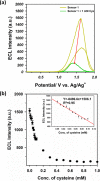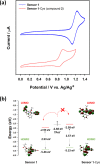Photoluminescence and Electrochemiluminescence Dual-Signaling Sensors for Selective Detection of Cysteine Based on Iridium(III) Complexes
- PMID: 31460382
- PMCID: PMC6682121
- DOI: 10.1021/acsomega.9b01501
Photoluminescence and Electrochemiluminescence Dual-Signaling Sensors for Selective Detection of Cysteine Based on Iridium(III) Complexes
Abstract
Cysteine (Cys) is important in biosynthesis, detoxification, and metabolism. The selective detection of Cys over structurally similar homocysteine (Hcy) or glutathione (GSH) remains an immense challenge. Although there are many methods for detecting Cys, photoluminescence (PL) and electrochemiluminescence (ECL) techniques are well-suited for clinical diagnostics and analytical technology because of their high sensitivities. Herein, we report PL and ECL dual-channel sensors using cyclometalated iridium(III) complexes for the discrimination of Cys from Hcy and GSH. The sensors react with cysteine preferentially because of kinetic differences in intramolecular conjugate addition/cyclization, enabling phosphorescence enhancement and ECL decrease in the blue-shifted region. Sensor 1 shows ratiometric PL turn-on and ECL turn-off for Cys. In addition, unique ECL-enhancing behavior of sensor 1 toward GSH enables discrimination between Cys and GSH. Sensor 1 was successfully applied to the detection of Cys in human serum by the ECL method. We demonstrate the first case of a Cys-selective PL and ECL dual-channel chemodosimetric sensor based on cyclometalated iridium(III) complexes and expect that the rational design of efficient PL and ECL dual-channel sensors will be useful in diagnostic technology.
Conflict of interest statement
The authors declare no competing financial interest.
Figures









Similar articles
-
Amino group-driven distinguishing homocysteine from cysteine and glutathione in photoluminesecent signal of the iridium(III) complexes.Spectrochim Acta A Mol Biomol Spectrosc. 2021 Dec 15;263:120167. doi: 10.1016/j.saa.2021.120167. Epub 2021 Jul 10. Spectrochim Acta A Mol Biomol Spectrosc. 2021. PMID: 34280797
-
Electrochemiluminescent chemodosimeter based on iridium(III) complex for point-of-care detection of homocysteine levels.Biosens Bioelectron. 2017 May 15;91:497-503. doi: 10.1016/j.bios.2017.01.010. Epub 2017 Jan 5. Biosens Bioelectron. 2017. PMID: 28082238
-
A "switch-on" photoluminescent and electrochemiluminescent multisignal probe for hypochlorite via a cyclometalated iridium complex.Anal Chim Acta. 2019 Oct 3;1074:98-107. doi: 10.1016/j.aca.2019.05.023. Epub 2019 May 16. Anal Chim Acta. 2019. PMID: 31159944
-
Cyclometalated iridium(III) complexes for phosphorescence sensing of biological metal ions.Inorg Chem. 2014 Feb 17;53(4):1804-15. doi: 10.1021/ic4013872. Epub 2013 Nov 22. Inorg Chem. 2014. PMID: 24266501 Review.
-
Cyclometalated iridium(III) chelates-a new exceptional class of the electrochemiluminescent luminophores.Anal Bioanal Chem. 2016 Oct;408(25):7013-33. doi: 10.1007/s00216-016-9615-8. Epub 2016 Jun 2. Anal Bioanal Chem. 2016. PMID: 27255104 Free PMC article. Review.
Cited by
-
Reaction-based energy level modulation of a cyclometalated iridium complex for electrochemiluminescent detection of formaldehyde.RSC Adv. 2023 Nov 1;13(46):32070-32076. doi: 10.1039/d3ra06936b. eCollection 2023 Oct 31. RSC Adv. 2023. PMID: 37920760 Free PMC article.
-
Advances on Electrochemiluminescent Biosensors for TB Biomarkers.ACS Sens. 2025 Apr 25;10(4):2409-2430. doi: 10.1021/acssensors.4c03517. Epub 2025 Apr 9. ACS Sens. 2025. PMID: 40202785 Free PMC article. Review.
References
-
- Nagy P.; Winterbourn C. C. In Advances in Molecular Toxicology; Fishbein J. C., Ed.; Elsevier: 2010; Vol. 4.
-
- Wang L.-J.; Lin P.-Y.; Lee Y.; Huang Y.-C.; Wu C.-C.; Hsu S.-T.; Chen C.-C.; Chong M.-Y.; Lin C.-H.; Hung C.-F. Increased serum levels of cysteine in patients with schizophrenia: A potential marker of cognitive function preservation. Schizophr. Res. 2018, 192, 391.10.1016/j.schres.2017.03.041. - DOI - PubMed
LinkOut - more resources
Full Text Sources
